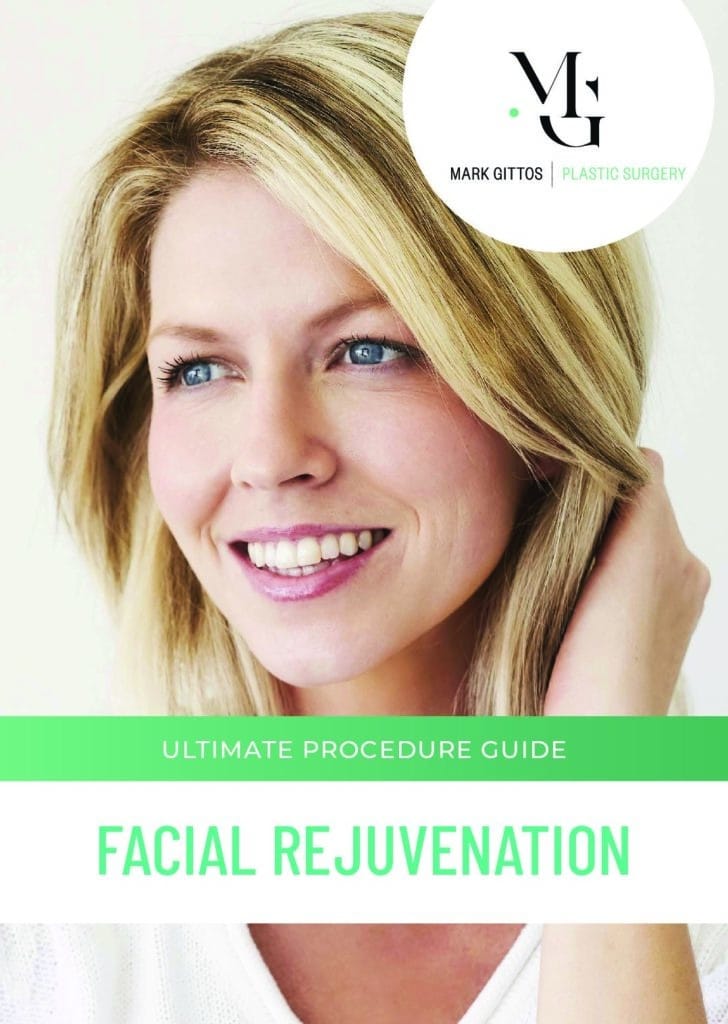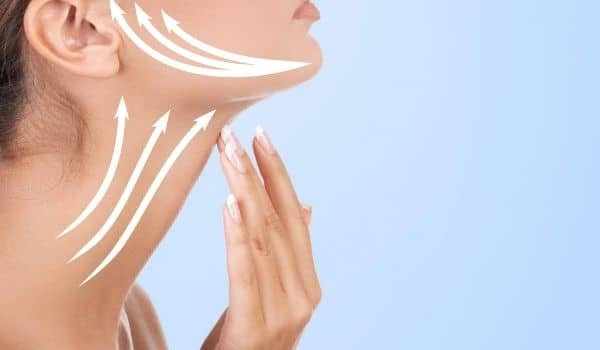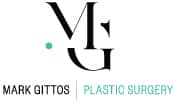Lower Facelift Surgery – Rhytidectomy in Auckland New Zealand by Dr Mark Gittos Plastic Surgeon
If you want to reduce the early signs of ageing, a lower facelift surgery might be a good option for you. The primary goal of a facelift is to reverse the ageing process and deliver a more youthful appearance. For younger patients, a lower facelift or mini facelift can be tailored towards their unique face and aesthetic goals.
Auckland Plastic Surgeon and facelift expert Dr Mark Gittos often performs facelift procedures. This is a detailed overview of a lower facelift surgery.
Understanding the Different Types of Face Lift Procedures
Download Dr Mark Gittos’ Guide to Facial Rejuvenation Surgery – Surgical and Non Surgical Anti-Aging

As your body ages, the skin starts to lose its elasticity. The facial tissues also lose their volume. With time, the jowls develop loose skin and wrinkles. Although this is a normal part of the ageing process, many patients are using a lower facelift to turn back the clock and look more like a younger version of themselves.
If you are considering a facelift, it’s critical to understand which type of facelift is best meant to fit your needs. The first thing is to understand the different terms “lower face”, “upper face”, and “mid face”. Hence the “lower facelift”, “upper facelift”, and “mid facelift”.
Overall, the upper face procedure targets anything above the eyes, such as the forehead and brow line. Whereas the midface procedure is more focused on the area from the corners of the eyes to the mouth. That also means the spot over the upper lip, cheeks, and nose. This is a common areas for volume loss.
Then, there is the lower facelift procedure, which targets all the areas under the corners of the mouth. That includes the jawline and laugh lines (nasolabial folds). In patients in need of a lower facelift, the procedure will tackle the spots below the chin. In other words, the procedure targets the lower two-thirds of your face.
With that in mind are other types of facelifts. Such as a traditional facelift, deep plane facelift and mini-facelift. A mini face lift is best meant for patients who have a very mild degree of skin sagging. This is a less invasive procedure compared to a deep plane or traditional facelift. All thanks to the smaller incisions used to tighten deep facial tissues.
A traditional (standard) facelift is meant to handle advanced / moderate ageing around the neck and midface area. It’s more extensive and has a longer recovery time. However, the final results could be more impressive. This procedure can bring back the youthful contour of the neck and face.
What Is the Difference Between a Mini Facelift and a Lower Facelift?
The mini facelift works with areas of the upper neck and jowls. Often referred to as a short-scar facelift or S lift, a mini facelift is a procedure meant for younger individuals. It takes care of some minor sagging on the neck and lower regions of the face.
These results, however, are shorter-lived than a standard lower facelift. That’s because surgeons use a smaller incision to get the desired results. A patient who has recently had a mini facelift won’t need as much time to recover as someone who had a full facelift.
Some patients decide to combine a mini facelift with other procedures, like an eyelid lift or a brow lift. This can give them some facial rejuvenation and amplify the results. While a full facelift could also tackle regions such as the neck and mid face.
The primary difference is in how big the incisions are. As a result, patients are advised to have realistic expectations when it comes to a short-scar facelift.

Lower Face Lift Vs. Neck Lift: What’s the Difference?
A question that often pops up is “what is the difference between a neck lift and a lower facelift”? Neck lift surgery is meant to turn back the clock in areas like the low jawline and neck. This is a go-to choice for those struggling with excess or loose neck skin.
The primary goal is to eliminate skin excess and get rid of the fatty tissue under the chin. The fatty deposits create abnormal contours, which can affect the patient’s self-esteem. Based on the desired outcome of the treatment, Dr Gittos might suggest a full neck lift or a limited incision neck lift.
The latter is created by adding incisions just around the ear. Since these are smaller and shorter incisions, scars are not that evident.
But does a lower facelift include the neck? The lower face procedure targets all segments under the corners of the mouth. That includes the jawline and laugh lines. In many patients, the procedure can treat areas below the chin.
Experts from the National Institutes of Health evaluated the impact of the neck and lower facelift combined method. To study the outcome of both techniques, 44 patients were evaluated between 2012 and 2015. Results were beneficial. Patients had better-looking skin on their treated areas.
A drastic difference was noticed before and after the procedures. The combined methods helped treat factors that made the skin look older in the neck and lower third of the face. This method offers a lasting and positive outcome with a few complications.
Areas Targeted With a Lower Facelift
When the skin starts to sag, it can completely change the shape and overall look of the face. Particularly some facial features you used to find appealing. That’s where a lower facelift can come in handy. This is a highly individualised procedure mostly performed on patients over the age of 50.
But, since there is no age requirement, patients as young as 40 might qualify for treatment. But, it depends on their current health and the quality of the skin.
With that in mind, a lower facelift is meant to re-drape the skin and give it a smoother surface. It can target the following five areas of the face. They include:
- Corners of the mouth
- Deep wrinkles on the face
- Loose jawline skin
- Loose neck skin
- Jowls
People seek treatment because the loose skin has had a drastic impact on their self-image and confidence. Due to current technological advances and years of knowledge, the lower facelift procedure has significantly improved compared to its initial phases. Becoming the reliable procedure that it is today so that patients can use it to feel and look good.

Risks and complications of a Lower Face Lift Surgery
Of course, no surgery is without its downsides. Just like any other medical procedure out there, this one comes with potential complications and risks. Among them we can mention scarring, bruising, damage to some facial nerves, etc. Find out more details about risks of plastic surgery from Dr Gittos’s risks page.
Results after a Lower Facelift
It is different for everyone. Both a full and a mini facelift will alter the skin and tissue on the targeted area. But, because of the various incision methods used, one lasts longer than the other. A mini facelift might last about 10 years before you need another procedure.
Recovery after a Lower Facelift Surgery
The procedure is often performed with the patient under anaesthesia, so this means that you will feel no pain or discomfort.
Bruising and swelling are normal after a facelift surgery. Often they are accompanied by a certain level of pain and discomfort. But, the pain meds you will be prescribed should keep you comfortable.
Numbness in the area treated could also occur, as well as itching as the tissues heal. Keep in mind that these side effects could last for a couple of weeks and they often disappear without any additional treatment. For more information read the recovery after surgery page.
How much does a lower face lift cost?
The total cost of a facelift can be divided into numerous components. Like hospital stay, surgeon fees, anaesthesia, and follow-up visits. The lower facelift cost in New Zealand will vary based on these factors. See the NZ Surgery pricing page for more information.
Dr Gittos’ team will provide you a customised fee for your surgery depending on the type of procedure, hospital and how long you want to stay in hospital. An approximate fee range for your lower face lift surgery can be provided over the phone when you speak to a Patient Care Advisor. We also provide information on lower face lift payment plans and different methods of payment.
Lower Facelift FAQs

What is the best age to get a lower facelift?
- A lower facelift is rarely performed on patients under the age of 30. Ideally, you should be in your 40s, 50s, or 60s for best resultst. Talk to Dr Gittos to find out if you are a good candidate for treatment.
Is a lower facelift worth it?
- If you are looking for a youthful and smoother appearance, then the procedure can be worth it. It is meant to lift the corners of the mouth, curb the creases, and tighten the saggy skin. After the skin completely heals, you can see the final results and feel more confident
How invasive is a lower facelift?
- To reduce the pain, scarring, and potential adverse effects, people choose to get a lower facelift. It is considered less invasive compared to a full facelift. It is designed to reposition and lift saggy skin
What is the best procedure for sagging jowls?
- For someone who deals with sagging jowls or substantial laxity in this area, a neck lift surgery becomes the most viable choice. However, the lower facelift surgery could also be a good option. The right solution for you will be indicated during the initial consultation with Dr Gittos.
What is pixie ear after a facelift?
- During a facelift, the jawline and cheek skin flaps create tension at the earlobe attachment point. This tension can lead to an ear deformity known as a “pixie ear”. The ear adopts a more pulled or stuck-on appearance, which for some patients may be off-putting. When the pixie ear is too severe, doctors may suggest you do a revision treatment. ALways choose the best plastic surgeon to get the best facelift result.
Further Reading and Medical References about Lower Facelift
- https://www.plasticsurgery.org/news/blog/comparing-upper-facelift-mid-facelift-and-lower-facelift
- https://www.americanboardcosmeticsurgery.org/procedure-learning-center/face/facelift-guide/
- https://www.plasticsurgery.org/cosmetic-procedures/neck-lift
- https://pubmed.ncbi.nlm.nih.gov/29545030/
- https://www.medicalnewstoday.com/articles/244066#complications
- https://pubmed.ncbi.nlm.nih.gov/23190814/
About Dr Mark Gittos FRACS (Plast) – New Zealand Plastic Surgeon
Practice locations in Herne Bay Auckland, Northland and Bay of Plenty – Kerikeri, Whangarei, New Plymouth & Tauranga
Dr Mark Gittos is a leading Specialist Plastic Surgeon and operates a practice in Herne Bay, Auckland and in the UK. The practice focuses on both surgical and non-surgical procedures, each designed to help restore, improve or change a physical characteristic or problem. The first step in every case is to talk through your personal requirements and explore all the options, before deciding on the most effective solution.
Dr Mark Gittos offers high quality, natural-looking cosmetic surgery results and is highly experienced in Breast, Body and Face Surgery having performed over 4000 Surgeries in the last 26 years. With worldwide expertise Dr Gittos is an expert in breast, face and body surgery for men & women.
Naturally, before any treatment is begun, we will explain clearly the advantages and risk factors; so that you have the information you need to make an informed decision that is best for you. Visit the practice to find out more.

NEXT STEPS
Do your Research
- Read the Website and Blogs relevant to your procedure
- Browse our Frequently Asked Questions including how to choose a Surgeon for your procedure
- Download and read the FREE Guides to Surgery
What to Bring to your Plastic Surgeon Consultation
- Bring a friend or relative to help discuss the information and your choices
- Take lots of notes and read the documents provided thoroughly
- Dress in simple clothes as you may need to undress for examination
- Bring your medical referral and any relevant medical documents or test results
Book your Initial Surgery Consultation
- A Referral from your GP or specialist is helpful but NOT essential – you can have a consultation without a GP Referral
- Email us or Call on 09 529 5352 to arrange your surgeon consultation appointment.
- Book a consultation with Dr Gittos by paying the Consultation Fee – $325 incl GST
Please contact us to arrange to book a consultation with our Specialist Plastic Surgeon or to speak with our Patient Care Advisor.
Send an enquiry form today or phone 09 529 5352 during Clinic Hours
